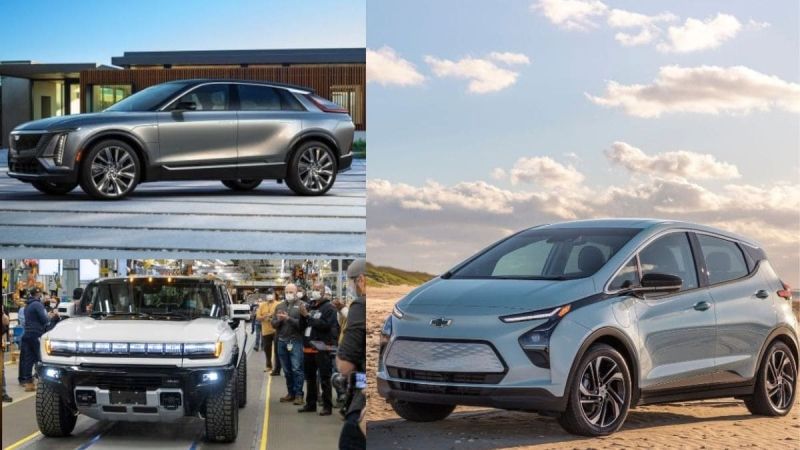But what would that really mean? How many EVs, based on last year’s volumes as a starting point, would GM have to sell in 2023 to surpass its closest rivals and claim the #2 spot? And just what would be the difference between #2 and #1 spots (which will undoubtedly be claimed by Tesla, yet again)?
Previously, I pointed out that it was really the Hyundai Motor Group (HMG), not Ford, which sold the 2nd largest number of EVs in the US in 2022. I estimated that HMG sold approximately 72,480 EVs in the US last year, besting Ford-Lincoln (at 61,575 Ford EVs, because Lincoln doesn’t currently sell any). This compares to GM’s US EV sales last year of 39,096.
Obviously, all automakers want to grow their sales year over year. EVs were a major part of what growth there was last year (a year still impacted by pandemic induced supply chain woes) and they should play an even greater part this year given that the major players among the legacy manufacturers are all trying to catch up to Tesla (well, most of them are).
So it is realistic to start with last years figures as a baseline and to suggest that if GM wants to beat all the other legacy carmakers, it must sell more than 72,480 EVs this year, or roughly double the number of EVs it sold last year. Frankly, that seems feasible with 7 EV models on sale by the end of the year, assuming GM can manufacture enough of the models that are likely to sell in the highest volume (which would be their EVs that will cost $50k or less: the Bolt EVs, the Chevy Equinox, and some models of the Silverado and Blazer EVs).
Since well over 90% of all the EVs GM sold last year were the two variants of the Chevy Bolt, often the lowest priced EV on the market in recent years, it does seem likely that is where GM will focus most of its production. I say this because, even though GM has promised to scale up production of its Cadillac Lyriq EV in 2023, the market for electric vehicles costing over $50k is going to have the most competition (because it already does) and the under $50k segment of the market thus has more untapped opportunity.
So get ready shoppers looking for subcompact and compact SUV-like EVs, GM wants to sell you lots of Bolts and Equinoxes this year (and several thousand luxury and or tarted up EV pickups and SUVs too)!
As electrek.com points out, GM already has a versatile, dedicated electric vehicle platform (called Ultium) which can be used for vehicles ranging in size from small compacts to large delivery vans and trucks. While other manufacturers have dedicated EV platforms too, they may not have as much flexibility or may be in different stages, and thus GM has a bit of an advantage. And as greencarreports.com shared, GM is well positioned against its cross-town rivals as: Ford is capacity-constrained [when it comes to EVs] until Blue Oval City comes online in the second half of 2025, and Stellantis has their own limitations in the short term. So, with the possible exception of HMG, GM seems like it has a pretty clear path to becoming the 2nd largest EV producer in the US market this year.
However, there is one dirty little secret everyone should know about here, and greencarreports.com called it out in their piece too. In order for GM (and Ford, Stellantis etc.) to achieve the EV sales growth they are aiming for: it will take cost cuts for parts, better manufacturing efficiency, and, in some cases, ramped-up production of gasoline trucks to get there… [and] legacy automakers, particularly the U.S. Big Three, need cash-cow profits from full-size [gasoline] pickups to support their investments in EVs.
This should send a chill up our collective spines and take some of the bluster out of GM and Ford’s assertions about how many EVs they are going to sell in the next few years. If they have to rely on the sale of gas powered cash cows, they are going to hit a wall soon. This is because the EV market is supposed to roughly double every year for at least the next few years. If true, that would mean that by the end of next year, somewhere around 20% of all new cars will be EVs (or plug-in vehicles at least), and nearing 50% by the year after that.
How are GM, Ford and the others going to finance their switch to EVs if their sales of gas powered cars diminishes so rapidly?
Maybe this is where things start breaking down. Or maybe the downturn in the economy will pump the breaks on the growth of EVs. Regardless, we should question whether legacy brands are greenwashing their products and judge how serious they are about the move to EVs with news like this.
Finally, since GM said, back in 2021, that by 2025 it was going to beat Tesla we should look at Tesla and their EV sales as the moving target the rest of the brands are chasing. Tesla likely sold over 500,000 EVs in the US last year. They are most likely going to sell even more this year as output from their Texas factory scales and the first several thousand Cybertruck models are delivered, late in the year.
I don’t think GM has much of a chance of catching Tesla by 2025, but it is good to have goals. I do think GM could break the 100,000 EVs per year threshold by the end of 2024 (if not this year), and may even get close to 200,000 per year by the end of 2025 if their declining gas powered vehicle sales don’t undermine their plans.
What do you think the odds are that GM, Ford, or any other legacy maker will catch Tesla sometime this decade, dear readers? Please leave your questions and comments below.
Images courtesy of GM.
Justin Hart has owned and driven electric vehicles for over 15 years, including a first generation Nissan LEAF, second generation Chevy Volt, Tesla Model 3, an electric bicycle and most recently a Kia Sorento PHEV. He is also an avid SUP rider, poet, photographer and wine lover. He enjoys taking long EV and PHEV road trips to beautiful and serene places with the people he loves. Follow Justin on Twitter for daily KIA EV news coverage.











